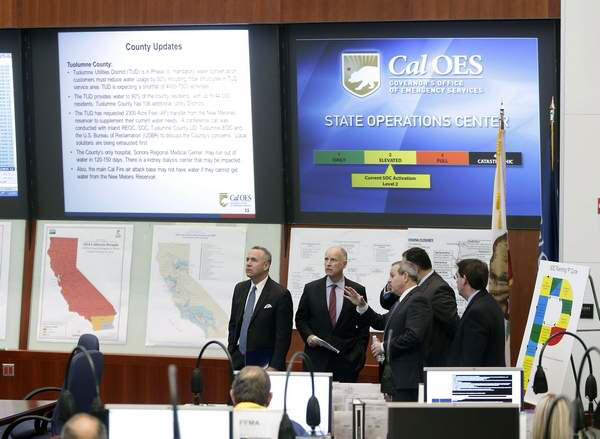|
www.capitalpress.com Governor plans $687
million for California drought
February 20, 2014 Capital Press
 California
Gov. Jerry Brown, second from left, is given a tour of the
California Emergency Services State Operations Center by OES
Director Mark Ghilarducci, third from left, in Mather, Calif.,
Wednesday, Feb. 19, 2014. Brown, accompanied by Senate President
Pro Tem Darrell Steinberg, D-Sacramento, left, and Assembly
Speaker John Perez, D-Los Angeles, fourth from left, behind
Ghilarducci, toured the facility before announcing a $687
million plan to provide immediate help to drought-stricken
communities throughout California. (AP Photo/Rich Pedroncelli) California
Gov. Jerry Brown, second from left, is given a tour of the
California Emergency Services State Operations Center by OES
Director Mark Ghilarducci, third from left, in Mather, Calif.,
Wednesday, Feb. 19, 2014. Brown, accompanied by Senate President
Pro Tem Darrell Steinberg, D-Sacramento, left, and Assembly
Speaker John Perez, D-Los Angeles, fourth from left, behind
Ghilarducci, toured the facility before announcing a $687
million plan to provide immediate help to drought-stricken
communities throughout California. (AP Photo/Rich Pedroncelli)
The Democratic plan, which now goes to the Legislature,
does not address long-term improvements to California’s water
supply and distribution system. Rather, it provides money for
immediate aid.
SACRAMENTO, Calif. (AP) — Gov. Jerry Brown and the top
Democratic lawmakers on Wednesday announced a $687 million plan
to provide immediate help to drought-stricken communities
throughout California, including $15 million for those with
dangerously low drinking water supplies.
The proposal comes amid one of the driest periods in the history
of the nation’s most populous state, forcing farmers to fallow
fields and some communities to warn of low water supplies.
“There’s many ways we can better use the water we have,” Brown
said during a news conference at a state office near Sacramento.
“You can’t manufacture water.”
The Democratic plan, which now goes to the Legislature, does not
address long-term improvements to California’s water supply and
distribution system. Rather, it provides money for immediate
aid.
Most of the money — $549 million — will come in the form of
accelerated spending from two bonds approved previously by
voters. It will go toward local water conservation and recycling
efforts, such as systems to capture stormwater and recharge
groundwater supplies.
The general fund, the state’s main checkbook, also will be
tapped. In addition to the money for emergency water supplies,
$25.3 million from the general fund will provide food assistance
in communities affected by the drought.
That would include areas of the Central Valley, among the
nation’s most productive farming regions, that are suffering
from high unemployment as agriculture-related jobs disappear.
The proposal also directs the State Water Resources Control
Board and the Department of Public Health to boost water
supplies by allowing for the use of recycled water and
stormwater. Increased penalties for illegally diverting water
also are part of the proposal.
Peter Gleick, a water scientist and director of the nonpartisan
Pacific Institute, said the proposals in the relief plan appear
to be good ideas.
“But it depends what they spend the money on, and how carefully
and quickly it’s spent,” Gleick said. “Whether it results in
long term help remains to be seen.”
Republican lawmakers, who were not included in the plan, said
more must be done to address the state’s long-term water needs.
They and many farmers have been advocating for more reservoirs
to store water.
“We need a real plan that increases storage for a growing
state,” Senate Minority Leader Bob Huff, R-Diamond Bar.
Assembly Republicans plan to propose legislation on Thursday
addressing long-term water needs.
Asked about whether he believes California needs more water
storage, Brown told reporters that for now he wants to focus on
immediate needs.
“That’s important, but of course storage takes a long time.”
The state legislative proposal comes as Republicans and
Democrats offer different solutions in Congress to deal with
California’s drought. The House approved a Republican-backed
bill that would temporarily halt the restoration of a dried-up
stretch of the San Joaquin River so more water could be diverted
to farms.
California’s two U.S. senators, Democrats Dianne Feinstein and
Barbara Boxer, have introduced legislation similar to the
proposal announced Wednesday by the governor. That bill would
put $300 million toward emergency aid, drought-relief projects
and water conservation.
“While Congress is locking their ideological horns over the best
way to help, so far nothing to show for it in the process,” said
Senate President Pro Tem Darrell Steinberg, who joined the
governor at the news conference along with Assembly Speaker John
Perez.
Both expected the plan to pass the Legislature and be sent to
the governor in a matter of weeks.
Most parts of California are under extreme drought conditions
after three winters with below-normal rain and snowfall. As many
as 17 communities are at risk of running out of drinking water
in the months ahead, and farmers throughout the state have been
fallowing fields and tearing up orchards.
The State Water Project, which supplies water to 25 million
Californians and about 750,000 acres of farmland, will deliver
no additional water later this year to its customers, the first
time in its 54-year history that it has given a so-called zero
allocation. That could change if precipitation picks up in the
weeks ahead.
Beyond Wednesday’s announcement, lawmakers still need to
negotiate changes to an $11.1 billion water bond that is on the
November ballot, a measure that is supposed to provide the
longer-term fixes sought by farmers and cities.
———
Associated Press writer Jason Dearen contributed to this report.
- See more at:
http://www.capitalpress.com/article/20140220/ARTICLE/140229998/1184?utm_source=Capital+Press+Newsletters&utm_campaign=e2c560ec6b-Daily_Ag_Update&utm_medium=email&utm_term=0_4b7e61b049-e2c560ec6b-69639325#sthash.DYR2dNoS.dpuf
====================================================
In accordance with Title 17 U.S.C.
section 107, any copyrighted material
herein is distributed without profit or
payment to those who have expressed a
prior interest in receiving this
information for non-profit research and
educational purposes only. For more
information go to:
http://www.law.cornell.edu/uscode/17/107.shtml |

